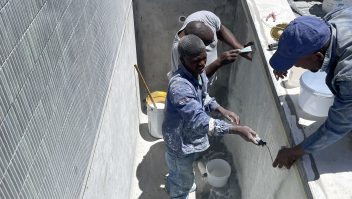Introduction
Priming your pool pump is a crucial step to ensure efficient water circulation and prevent motor damage. If your pump is running dry or not pulling water, it’s time to prime your pool pump properly. Whether you’re a DIY enthusiast or a pool owner in Cape Town looking to avoid costly repairs, this guide is for you.
At Pools Reno, we provide professional swimming pool pump installations, repairs, and maintenance services across Cape Town and the Western Cape.
What Is Pool Pump Priming?
Priming a pool pump means filling it with water to eliminate air and create proper suction. A dry-running pump can overheat quickly and cause motor damage or impeller burnout.
When do you need to prime your pump?
- After cleaning the basket or impeller
- Post-repair or installation
- If the pump is making a gurgling noise
- After draining the pool or plumbing system
Tools You’ll Need
- Garden hose or water bucket
- Teflon tape (for sealing leaks if needed)
- Screwdriver or wrench (for loosening lid or valves)
Step-by-Step: How To Prime a Pool Pump
Step 1: Turn Off the Power
Safety first. Always switch off the pump at the breaker to avoid injury or equipment damage.
Step 2: Open the Pump Lid
Remove the lid from your pool pump basket. Check for debris and rinse out leaves or dirt.
Step 3: Fill the Pump Basket With Water
Use a hose or bucket to fill the pump chamber until it’s full. This primes the pump and removes trapped air.
Step 4: Check All Valves and O-rings
Ensure suction valves are open and O-rings are properly sealed. A loose or cracked seal will draw air.
Tip: Apply pool-safe silicone lubricant to O-rings to prevent leaks.
Step 5: Replace the Pump Lid Tightly
Secure the lid, ensuring a watertight seal.
Step 6: Turn On the Pump
Switch the pump on at the power source. It should begin pulling water within 30–60 seconds. If not, repeat the steps.
Step 7: Watch for Air Bubbles and Pressure Build-Up
Check the return jets for bubbles. The pressure gauge should begin to rise, indicating successful priming.
Troubleshooting: Pump Still Not Priming?
If your pump still won’t prime:
- Check for air leaks in the suction line
- Inspect the impeller for clogs
- Examine the multiport valve for damage
- Call a pool technician if unsure – continued dry running can ruin the pump
Need expert help? Book a pump service in Cape Town.
Pool Pump Maintenance Tips
- Prime your pump after any service or power failure
- Clean out the pump basket weekly
- Inspect and replace worn gaskets and O-rings
- Don’t let the water level fall below the skimmer
Bonus: How to Clean Out a Pool Pump Impeller
Pool Pump Services in Cape Town
At Pools Reno, we offer:
- Expert pump priming and diagnostics
- Full pump installations
- Shaft seal and capacitor replacements
- Leak detection and impeller servicing
- Weekly, monthly and seasonal pool maintenance plans
Serving Brackenfell, Durbanville, Bellville, Stellenbosch, and all Cape Town suburbs.
Internal Links
- Common Pool Pump Issues and How to Fix Them
- Complete Guide to Pool Pump Installation in Cape Town
- How to Replace Your Pool Pump Shaft Seal
External Sources
- Hayward Pool Pumps – Owner’s Manual
- South African Weather Service – Pool Care During Seasonal Changes
FAQ – Pool Pump Priming
Q: How long should I run the pump after priming?
A: At least 15–20 minutes to confirm continuous flow and check for any air leaks.
Q: What if I can’t get the pump to hold prime?
A: Check for cracked suction lines, faulty lid seals, or clogged plumbing.
Q: Is priming necessary for variable-speed pumps?
A: Yes, all pool pumps need priming—even variable-speed models with self-priming features.



